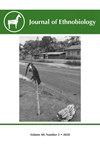民族历史记录作为破译接触前加勒比刺鼠共生关系的宝贵资源(刺鼠科:刺鼠科)
IF 1.3
3区 社会学
Q1 ANTHROPOLOGY
引用次数: 0
摘要
摘要新热带啮齿动物刺鼠(Dasyprocta sp.),可以说是小安的列斯群岛上最突出的接触前的共生生物之一,长期以来一直被认为是由土著加勒比群体管理和圈养的。然而,这些说法至今仍未得到证实。民族历史文献可作为建立阿古提与加勒比土著群体共享的共生关系的宝贵资源。在这里,我综合了来自17世纪法国民族历史文献的证据,以解决接触前刺虱管理和囚禁的问题,并具体说明将刺虱与土著群体联系起来的许多其他共生关系。民族历史文献显示,除了通过花园狩猎来管理外,刺鼠在靠近定居点的地方被驯服,尽管它们似乎没有被圈养。Agoutis也与人类住区分离,与人类群体保持最小程度的互动。民族历史文献反复将刺骨和刺骨元素与仪式实践联系起来,表明仪式/宇宙学价值。这项研究表明,民族历史文本在证实接触前的共生关系方面具有重要潜力,并且可以进一步深入了解土著身份、生活方式和岛屿生态。本文章由计算机程序翻译,如有差异,请以英文原文为准。
Ethnohistoric Accounts as Valuable Resources for Deciphering Commensal Relationships of Pre-Contact Caribbean Agouti (Dasyproctidae: Dasyprocta)
Abstract. The Neotropical rodent agouti (Dasyprocta sp.), arguably one of the most prominent pre-Contact introduced commensals of the Lesser Antilles, has long been proposed as having been managed and maintained in captivity by Indigenous Caribbean groups. These claims, however, remain so far unsubstantiated. Ethnohistoric texts may serve as valuable resources for establishing the commensal relationships agouti shared with Indigenous Caribbean groups. Here, I synthesize the evidence from seventeenth century French ethnohistoric texts to address the question of pre-Contact agouti management and captivity and concretize some of the many other commensal relationships linking agouti to Indigenous groups. Ethnohistoric texts reveal that, in addition to having been managed through garden hunting, agoutis occurred as tame, in close proximity to settlements, although they do not appear to have been maintained in captivity. Agoutis also occurred as detached from human settlements, maintaining minimal interaction with human groups. Ethnohistoric texts repeatedly associate agoutis and agouti skeletal elements with ritual practices, suggesting ceremonial/cosmological value. This study shows that ethnohistoric texts hold critical potential for substantiating pre-Contact commensal relationships and, by extension, may offer insight into Indigenous identities and lifeways, and island ecology.
求助全文
通过发布文献求助,成功后即可免费获取论文全文。
去求助
来源期刊

Journal of Ethnobiology
Social Sciences-Anthropology
CiteScore
4.80
自引率
3.40%
发文量
21
审稿时长
>12 weeks
期刊介绍:
JoE’s readership is as wide and diverse as ethnobiology itself, with readers spanning from both the natural and social sciences. Not surprisingly, a glance at the papers published in the Journal reveals the depth and breadth of topics, extending from studies in archaeology and the origins of agriculture, to folk classification systems, to food composition, plants, birds, mammals, fungi and everything in between.
Research areas published in JoE include but are not limited to neo- and paleo-ethnobiology, zooarchaeology, ethnobotany, ethnozoology, ethnopharmacology, ethnoecology, linguistic ethnobiology, human paleoecology, and many other related fields of study within anthropology and biology, such as taxonomy, conservation biology, ethnography, political ecology, and cognitive and cultural anthropology.
JoE does not limit itself to a single perspective, approach or discipline, but seeks to represent the full spectrum and wide diversity of the field of ethnobiology, including cognitive, symbolic, linguistic, ecological, and economic aspects of human interactions with our living world. Articles that significantly advance ethnobiological theory and/or methodology are particularly welcome, as well as studies bridging across disciplines and knowledge systems. JoE does not publish uncontextualized data such as species lists; appropriate submissions must elaborate on the ethnobiological context of findings.
 求助内容:
求助内容: 应助结果提醒方式:
应助结果提醒方式:


